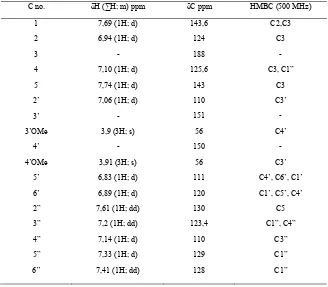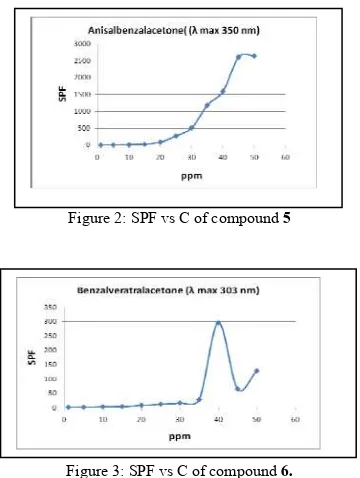SYNTHESIS AND ACTIVITY TEST OF TWO ASYMMETRIC DIBENZALACETONES AS POTENTIAL SUNSCREEN MATERIAL
SRI HANDAYANI
Chemical Education Department, Yogyakarta State University, Karangmalang Yogyakarta, 55281, Indonesia
Synthesis and activity test as potential sunscreen material of two asymmetric dibenzalacetones have been conducted. The first compound, anisalbenzalacetone was synthesized from benzaldehyde, acetone and p-anisaldehyde. The second, benzalveratralacetone was synthesized from benzaldehyde, acetone and veratraldehyde. Those compounds were synthesized by crossed aldol condensation in base condition with water-ethanol solvent. The synthesize of both compounds using ice bath throughout the stirring. The precipitate was purified by coloumn chromatography. Each product was characterized by FTIR, 1H-NMR, 13C-NMR, HMQC and HMBC. Activity test as UV protection was done by Walter method. The result showed that anisalbenzalacetone active in UV-A area, while benzalveratralacetone protection is in UV-B area.
1. Introduction
Global warming issue have been attained most attention during last decade. The “holes” in ozone layer have lead more UV radiation emitted to earth’s surface. There are three types of UV light namely UV-A (320-400nm), UV-B (280-320nm) and UV-C (100-280nm). UV-A radiation could cause collagen breaken that lead to premature aging such as wrinkle skin. UV-B could make skin damaged which lead to sun-burned and cancer skin. The most dangerous radiation UV-C light, fortunately could be absorp by ozone layer, so it could not reach earth’s surface [1]. Therefore, there is a need a compound that used for protection of danger sun light radiation.
Some of reported compound that used for sunscreen are benzalacetone and its derivatives. Handayani and Arty have synthesized 1(E),4(E)-1.5-diphenyl-1,4-pentadiene-3-one and its derivatives which known as symmetrical dibenzalacetone that have been made by crossed aldol condensation between acetone:benzaldehyde (1:2). It have been tested as a radical hydroxyl scavenger [2], and as potential sun screen material [3]. Another synthesized of dibenzalacetone was report by Guofeng et.al give an excellent yields [4]. Tutik D has synthesized symmetrical dibenzalacetone which have similar structure with the cinnamic acid derivative [5]. From its structure, it could be estimated that benzalacetone and dibenzalacetone, which have similar structure with cinnamic acid or its derivative, have ultraviolet absorption in the same range. Thus, asymmetric dibenzalacetone was predicted as a sunscreen. Asymmetric dibenzalacetone is dibenzalacetone that its
two benzene rings have different number, kind and/or position of substituent. In this research two of asymmetric dibenzalacetones, compounds 5 and 6 namely anisalbenzalacetone (1(E),4(E)-1-(4’-methoxy-phenyl)-5-phenyl-1,4-pentadiene-3-one) and benzal-veratralacetone (1(E),4(E)-1-(3’,4’-dimethoxy-phenyl)-5-phenyl-1,4-pentadiene-3-one) will be synthesized and tested as sunscreen material.
2. Experimental Section
2.1.Materials
All materials used from Merck, among other acetone, 4-methoxybenzaldehyde (p-anisaldehyde), 3,4-dimethoxybenzaldehyde (veratraldehyde), chloroform ethanol, benzaldehyde, hexane, and ethyl acetate. TLC was carried out using 0.25-mm plate Silica gel Merck 60 F254, column chromatography were performed by Silica gel 60 (230-400 mesh).
2.2.Instrumentation
The 1H, 13C-NMR, HMQC and HMBC Spectra were recorded on 500 MHz Jeol spectrophotometer. IR spectra were conducted using a Shimadzu 8300 FTIR spectrometer.
2.3. Synthesis of Compound 5
2
Figur comp
- henyl-1,4-pentadiene-3-one or benzalveratralacethenyl-1,4-pentadiene-3-one.
reaction mixture which then filtered. The extract was washed with water (20 ml x 3) and separated by column chromatography (d 2.5 cm, h 50 cm), with silica gel 60 (230-400 mesh) as the stationary phase and ethylacetate-hexane 1 : 9 as the eluent. The target compound (5) was identified using thin layer chromatography with ethylacetate-hexane 5:1 as the mobile phase.
2.4. Synthesis of Compound 6
The similar procedure was repeated for 3,dimethoxybenzaldehyde to replace 4-methoxybenzaldehyde in order to synthesize compound 6 (Figure 1). Four fractions obtained from the column chromatography, and the target compound was identified using thin layer chromatography with chloroform-hexane 4: 6.
2.5.In Vitro Test as Potential Sunscreen Material
Activity test as sunscreen using in vitro method have been done by : Sample was dissolved in ethanol by various concentration 0f 1-50 ppm. The concentration of 1 ppm was used to measure optimum wavelength. The absorbances all variation concentration solution have been measured at optimum wavelength between 240-400 nm. The SPF (Sun Protection Factor) can be calculated following Walter formula as
SPF = 10A (1) Where A = absorbance of each solution. SPF level and UV light type could be determined, also C value which related to concentration that gives ultra protection at more than SPF 15.
3. Result and Discussion
Separation of crossed aldol condensation product between benzaldehyde, acetone and 4-methoxy-benzaldehyde was done by coloumn chromatography. The product from coloumn chromatography separation yielded 3 fractions, which were identified by TLC with hexane-ethylacetate 5:1 as the eluent. Retardation factor datas from TLC scanner showed that fraction II was the target of compound 5 (10,6%) determined as yellow residue. Fraction I and fraction II supposed to be benzalacetone and dianisalacetone as the side products of crossed aldol condensation reaction.
e 1: Scheme of cross aldol condensation to synthesized of ound 5 and 6.
Characterization of compound 5 by FTIR (KBr) resulted peaks on 3035; 2922; 2842; 1668; 1423; 1446; and 1175 cm-1. A series of one and two dimensional NMR spectroscopic experiment using HMQC and Heteronuclear Multitiple Bond Coherence (HMBC) patterns were performed to assign the proton and carbon resonance correlation of the com compounds. The signal pattern of the aromatic ring showed the influence of methoxy (OMe) in δ 3,8 (3H, s) ppm (Figure 1; Table 1). Therefore compound 5 is (1(E),4(E)-1-(4’-methoxyphenyl)-5-phenyl-1,4-pentadiene-3-one) or anisalbenzalacetone.
The preparation of compound 6 was initiated by the mixing of 1, 2 and 4 to give 6 (Figure 1). The yield of crossed aldol condensation between acetone, 3,4-dimethoxybenzaldehyde and benzaldehyde was a mixture consist of 4 compounds. It was separated by Column Chromatography (AcOEt-hexane, 1:9) to provide the asymmetric dibenzalacetone 6 (15,53%) determined as pale yellow oil.
The multiple bond correlation of HMBC supported the structure (Figure 1; Table 2). In the 1H-NMR spectrum (500 MHz, CDCl3), two patterns singlet, nine doublet and three double dublet were observed. The double dublet at δ = 7,2; 7,61; and 7,41 was assignable to H2”, H3” and H6” respectively. Two equivalence methoxy signals at δ 3,91 and 3,9 were assigned to C3’ and C4’. Support spectra data provided by the IR (KBr), which indicates the existence of C=O (1645cm-1), aromatic C=C (1514-1417 cm-1) and CO ether (1255-1139 cm-1). Therefore, the structure of 6 was 1(E),4(E) 1-(3’,4’-dimethoxyphenyl)-5-p
3
tection is 15 ppm at SPF
Table HMBC datas of compound 5
C no. Δ H δ HM z)
Anisalbenzalacetone (5) showed absorbance at UV-A area (λmax 350 nm). Minimal concentration of this
compound that can give ultra pro
4
oncentr ection i
0 ppm
Betw re potential use as
unscree oncentr
r SPF rating block slighty more UV-B rays, but none offers 100% protection [6]
high concentration could not be conc
f asymmetric dibenzalacetone through crossed aldol condensation reaction has been done
ow yields of the product was because
lin.Dermatol., 3(3), 185-191 sical Science, 19(2), 61-68
ence onesia,
] http://www.chemistrymag.org/cji/2004/061007ne.ht
s
5.
c ation of this compound for ultra prot at SPF 16,143 (Figure 3).
een those compounds, 5 mo
n, because it can give more SPF value at lower ation than 6.
3 s c
Figure 2: SPF vs C of compound 5
Figure 3: SPF vs C of compound 6.
Figure 2 and 3 showed that some concentrations have absorbance above 3, giving SPF value higher than 1000. Sunscreen with highe
The data from
iderate because device condition was not valid to measure compound with high absorbance. Also, for commercial application, it prefer minimal concentration that giving ultra protection.
4. Conclusion
Synthesis o successfully. L
there some other side products of the reaction. In this research, compound 5 more potent as sunscreen than 6 because it can give ultra protection at lower concentration.
Reference
[1] Moloney F.J., Collins S., Murphy G.M., 2002, Am.J.C
[2] Handayani, S. and Arty, I.S., 2008, Journal of Phy
[3] Handayani, S., and Arty I.S, “Synthesis and Activity Test of Some Compounds 1,5-diphenyl-1,4-pentadiene-3-one as Potensial Sun Screen Material”, Proc. Of the 1st International Seminar on sci and Technology (ISSTEC), Yogyakarta, Ind 2009
[4 m
[5] Tutik, D., Oksidasi Anetol dan Kajian Pengaruh Gugus Metoksi Turunan benzaldehide Terhadap Reaksi Kondensasi Benzoin dan Aldol Silang, Master Thesis, Gadjah Mada University, 1996.
[6]

